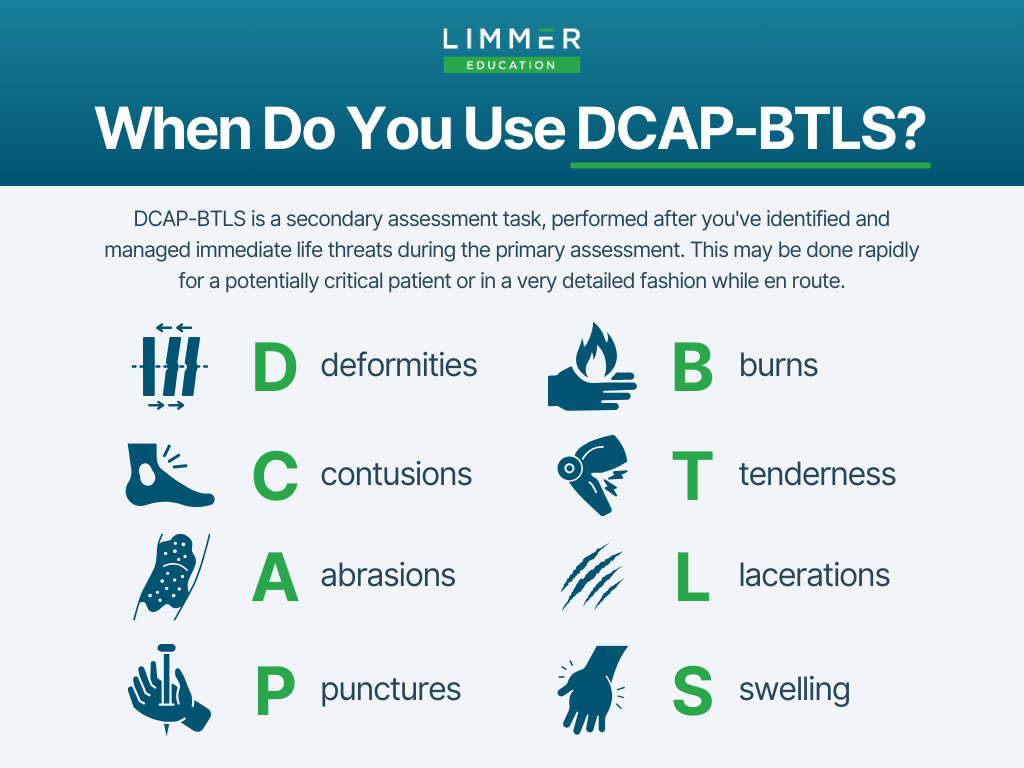
Dan Limmer, BS, NRP

by Limmer Education
Our articles are read by an automated voice. We offer the option to listen to our articles as soon as they are published to enhance accessibility. Issues? Please let us know using the contact form.
DCAP-BTLS is an acronym for things to look for in the head-to-toe assessment of the trauma patient—deformities, contusions, abrasions, punctures, burns, tenderness, lacerations, and swelling. First, remember this is more of a general guide. You don’t recite DCAP-BTLS for every body part—it would take forever!
We recently had one of our customers write confused about when to use this acronym. If you’ve ever felt confused about when to perform a full DCAP-BTLS assessment or what exactly belongs in the primary vs. secondary assessment, you’re not alone. This topic can be tricky—especially when preparing for the NREMT.
Let’s clear it up.
The full head-to-toe assessment using DCAP-BTLS is a secondary assessment task. That means it's performed after you've identified and managed any immediate life threats during the primary assessment. This may be done rapidly for a potentially critical patient or in a very detailed fashion while en route.

Yes, you might see a chest wound or severe leg bleeding as soon as you approach the patient. Those are things covered under DCAP-BTLS—but you’re not doing a full-body DCAP-BTLS exam during the primary. You're identifying and treating life threats. That’s the mantra: Life threats first. Always.
Life threats first. Always.
If you jump into palpating legs or checking for bruising without first managing major bleeding or securing the airway, you could be marked as failing on many skills sheets. That’s because you're not prioritizing correctly.
DCAP-BTLS is a helpful tool, but relying on it too early in the assessment process can lead you down the wrong path. For example, if your instinct is to start scanning and palpating every body part before addressing an open chest wound or providing oxygen, you’ve missed the point of the primary assessment.
Stay focused. Stay grounded in priorities. Life threats come first.
It’s unlikely the NREMT will test you with a “Where do you do DCAP-BTLS?” type of question. Instead, there are two main question formats you’re likely to encounter:
These questions ask you to select the highest priority task from a list. For example:
Seal an open chest wound
Apply oxygen
Splint a leg
Which comes first? The answer is the intervention that addresses the most immediate life threat—in this case, sealing the open chest wound.
These require you to sort actions into the correct assessment phase: primary or secondary. For instance:
Primary assessment tasks:
Determine criticality
Check the pulse
Control severe bleeding
Stabilize the cervical spine
Recognize shock via pulse, skin condition, and mental status
Secondary assessment tasks:
Palpate the abdomen
Identify a fracture
Place a cervical collar
You may be asked to drag these into the correct category. The NREMT is careful to avoid questions that could be misinterpreted, so they focus on broader assessment steps rather than memorized acronyms like DCAP-BTLS.
Here’s one last point to drive it home: Skills sheets are guides—not gospel. You need to be able to think in terms of patient care priorities. If a patient vomits during the secondary assessment? You go back to the primary and suction the airway. Because the airway always wins.
The takeaway: Know your assessments. Know your priorities. And always ask yourself—what will kill the patient first?

Dan Limmer, BS, NRP

Dr. Bill Young

Dan Limmer, BS, NRP